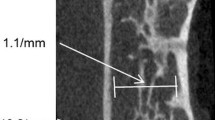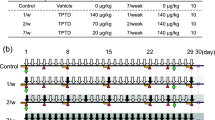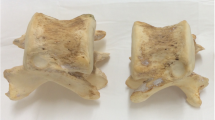Abstract
Characterization of trabecular bone structures requires necropsy of animals followed by a labor-intense histomorphometric or ex vivo micro-CT analysis. We tested the novel vivaCT40 from Scanco Medical AG (Bassersdorf, Switzerland), which allows monitoring such changes repeatedly in anesthetized rats and mice. Postmenopausal osteoporosis: in 8-month-old ovariectomized (OVX) rats, the vivaCT40 was capable of picking up the decrease in trabecular bone volume and trabecular thinning as well as the decrease in the number of trabecular elements as a function of time. The bone anabolic effects of parathyroid hormone [hPTH(l-34)], which resulted in an increase in trabecular thickness but not their number, as well as the bone protective effect of the two antiresorptive agents zoledronic acid (ZA) and 17-α ethinylestradiol (aEE), were detected correctly with the vivaCT40. Adjuvans arthritis: the vivaCT40 allowed measuring trabecular bone loss caused by periarticular inflammation in a rat model of adjuvans arthritis and demonstrated the bone protective effect of dexamethasone (DM). In addition, it was possible to image the subtle erosive lesions in subchondral bone caused by the inflammatory processes. Tumor osteolysis: the vivaCT40 allowed monitoring of the progressive osteolytic response following the local administration of 4T1luc2000 tumor cells into the tibia metaphysis of nude mice. The potent protective effect of ZA on tumor osteolysis was demonstrated. In summary, the new vivaCT40 can monitor the effects of known agents and diseases such as osteoporosis, inflammatory arthritis, and tumor invasion on 3-D trabecular microarchitecture accurately, repeatedly, reliably, and quickly in anesthetized rats and mice. The scanner represents a breakthrough for noninvasive imaging and structural measurements in small rodents.
Similar content being viewed by others
References
Seeman E (2002) Pathogenesis of bone fragility in women and men. Lancet 359(9320):1841–1850
Dempster DW (2003) The pathophysiology of bone loss. Clin Geriatr Med 19:259–270
Kleerekoper M, Villanueva AR, Stanciu J, Rao DS, Parfitt AM (1985) The role of three-dimensional trabecular microstructure in the pathogenesis of vertebral compression fractures. Calcif Tissue Int 37:594–597
Dempster DW (2000) The contribution of trabecular architecture to cancellous bone quality. J Bone Miner Res 15:20–23
Parfitt AM (1992) Implications of architecture for the pathogenesis and prevention of vertebral fracture. Bone 13(suppl 2):S41-S47
Goldstein SA, Hollister SJ, Kuhn JL, Kikuchi N (1990) The mechanical and remodeling properties of trabecular bone. In: Mow VC, Ratcliffe A, Woo SLY (eds) Biomechanics of Diarthrodial Joints, vol 2. Springer, New York, pp 61–81
Sosa M, Hernandez D, Segarra MC, Gomez A, dela Pena E1, Betancor P (2002) Effect of two forms of alendronate administration upon bone mass after two years of treatment. J Clin Densitom 5:27–34
Parfitt AM, Mathews CHE, Villanueva AR, Kleerekoper M, Frame B, Rao DS (1983) Relationship between surface, volume, and thickness of iliac trabecular bone in aging and in osteoporosis. Calcif Tissue Int 72:1396–1409
Ding M, Odgaard A, Linde F, Hvid I (2002) Age-related variations in microstructure of human tibial cancellous bone. J Orthop Res 20:615–621
Kohlbrenner A, Roller B, Haemmerle S, Ruegsegger P (2001) In vivo micro tomography. Adv Exp Med Biol 496:213–224
Kalu DN (1991) The ovariectomized rat model of postmenopausal bone loss. Bone Miner 15:175–191
Frost HM, Jee WS (1992) On the rat model of human osteopenias and osteoporoses. Bone Miner 18:227–236
Li M, Shen Y, Qi H, Wronski TJ (1996) Comparative study of skeletal response to estrogen depletion at red and yellow marrow sites in rats. Anat Rec 245:472–480
Lane NE, Thompson JM, Haupt D, Rimmel DB, Modin G, Kinney JH (1998) Acute changes in trabecular bone connectivity and osteoclast activity in the ovariectomized rat in vivo. J Bone Miner Res 13:229–236
Winter CA, Nuss GW (1966) Treatment of the adjuvant arthritis in rats with anti-inflammatory drugs. Arthritis Rheum 9:394–404
Guise TA, Mundy GR (1998) Cancer and bone. Endocr Rev 19:18–54
Thomas RJ, Guise TA, Yin JJ, Elliott J, Horwood NJ, Martin TJ, Gillespie MT (1999) Breast cancer cells interact with osteoblasts to support osteoclast formation. Endocrinology 140:4451–4458
Kitazawa S, Kitazawa R (2002) RANK ligand is a prerequisite for cancer-associated osteolytic lesions. J Pathol 198:228–236
Mancino AT, Klimberg VS, Yamamoto M, Manolagas SC, Abe E (2001) Breast cancer increases osteoclastogenesis by secreting M-CSF and upregulating RANKL in stromal cells. J Surg Res 100:18–24
Gasser JA (2003) Bone measurements by peripheral quantitative computed tomography in rodents. In: Helfrich MH, Ralston SH (eds) Bone Research Protocols. Humana, Totowa, NJ, pp 323–341
Laib A, Kumer JL, Majumdar S, Lane NE (2001) The temporal changes in trabecular architecture in ovariectomized rats assessed by microCT. Osteoporosis Int 12:936–941
Dempster DW, Cosman F, Kurland ES, Zhou H, Nieves J, Woelfert L, Shane E, Plavetic K, Muller R, Bilezikian J, Lindsay R (2001) Effects of daily treatment with parathyroid hormone on bone microarchitecture and turnover in patients with osteoporosis: a paired biopsy study. J Bone Miner Res 16:1846–1853
Jerome CP, Burr DB, Van Bibber T, Hock JM, Brommage R (2001) Treatment with human parathyroid hormone (1-34) for 18 months increases cancellous bone volume and improves trabecular architecture in ovariectomized cynomolgus monkeys (Macaca fascicularis). Bone 28:150–159
Ding M, Day JS, Burr DB, Mashiba T, Hirano T, Weinans H, Sumner DR, Hvid I (2003) Canine cancellous bone microarchitecture after one year of high-dose bisphosphonates. Calcif Tissue Int 72:737–744
Ito M, Nishida A, Nakamura T, Uetani M, Hayashi K (2002) Differences in three-dimensional trabecular microstructure in osteopenic rat models caused by ovariectomy and neurectomy. Bone 30:594–598
Author information
Authors and Affiliations
Corresponding author
About this article
Cite this article
Gasser, J.A., Ingold, P., Grosios, K. et al. Noninvasive monitoring of changes in structural cancellous bone parameters with a novel prototype micro-CT. J Bone Miner Metab 23 (Suppl 1), 90–96 (2005). https://doi.org/10.1007/BF03026331
Issue Date:
DOI: https://doi.org/10.1007/BF03026331




